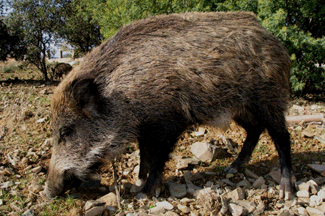The wild boar ("Sus scrofa") in the eco-epidemiology of "Rickettsia slovaca"

Spotted fever group (SFG) rickettsioses are endemic in North-eastern Spain, such as Mediterranean spotted fever which is mainly caused by Rickettsia conorii. Another SFG rickettsia present in our area is Rickettsia slovaca, considered the aetiological agent of TIBOLA –, an emerging disease transmitted by tick bite. Rickettsia slovaca was isolated and identified first from Dermacentor marginatus ticks. This tick species constitutes the most important vector in southern Europe and ungulates are its main hosts.
The first documented case of infection in human beings was reported in 1997. Since then, several clinical cases of TIBOLA have been reported in human beings in Europe (France, Spain, Hungary...). It represents 19% of tick-transmitted rickettsioses in Europe. The epidemiology of tick-transmitted diseases includes a wild transmission cycle and a domestic cycle, both connected by ticks. Although domestic cycle is considered the main source for human infection, the wild cycle should be taken into account since the increase in outdoors recreational activities has resulted in increased contact with tick vectors and are considered a risk factor. In our area, R. slovaca infection is associated to D. marginatus ticks, although several epidemiological aspects of this tick-borne rickettsioses are not completely clarified.
The aim of this study was to define whether wild boar play a role in the epidemiology of R. slovaca, since wild boar is one of the main hosts in the wild-cycle of D. marginatus in our area and this wild ungulate is overabundant, widely distributed in our forests and represents an important cynegetic species. Results suggested wild boar are exposed to R. slovaca infection and this pathogen is well established in the wild cycle of D. marginatus in our area.
References
"The role of wild boar (Sus scrofa) in the eco-epidemiology of R. slovaca in Northeastern Spain". Ortuño A., Quesada M., López-Claessens S., Castellà J., Sanfeliu I., Antón E., Segura F. VECTOR-BORNE AND ZOONOTIC DISEASES, 2007; 7: 59-64.


